YAMAHA XJR 1300 2000 Manual PDF
Manufacturer: YAMAHA, Model Year: 2000, Model line: XJR 1300, Model: YAMAHA XJR 1300 2000Pages: 95, PDF Size: 2.92 MB
Page 71 of 95
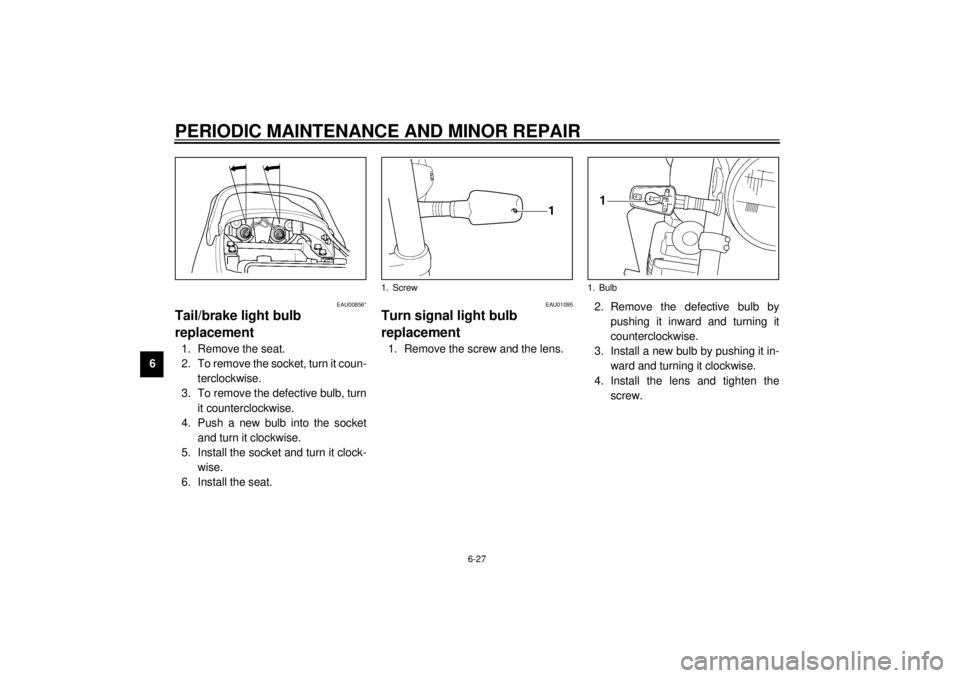
PERIODIC MAINTENANCE AND MINOR REPAIR
6-27
6
EAU00856*
Tail/brake light bulb
replacement1. Remove the seat.
2. To remove the socket, turn it coun-
terclockwise.
3. To remove the defective bulb, turn
it counterclockwise.
4. Push a new bulb into the socket
and turn it clockwise.
5. Install the socket and turn it clock-
wise.
6. Install the seat.
EAU01095
Turn signal light bulb
replacement1. Remove the screw and the lens.2. Remove the defective bulb by
pushing it inward and turning it
counterclockwise.
3. Install a new bulb by pushing it in-
ward and turning it clockwise.
4. Install the lens and tighten the
screw.1. Screw
1. Bulb
Page 72 of 95
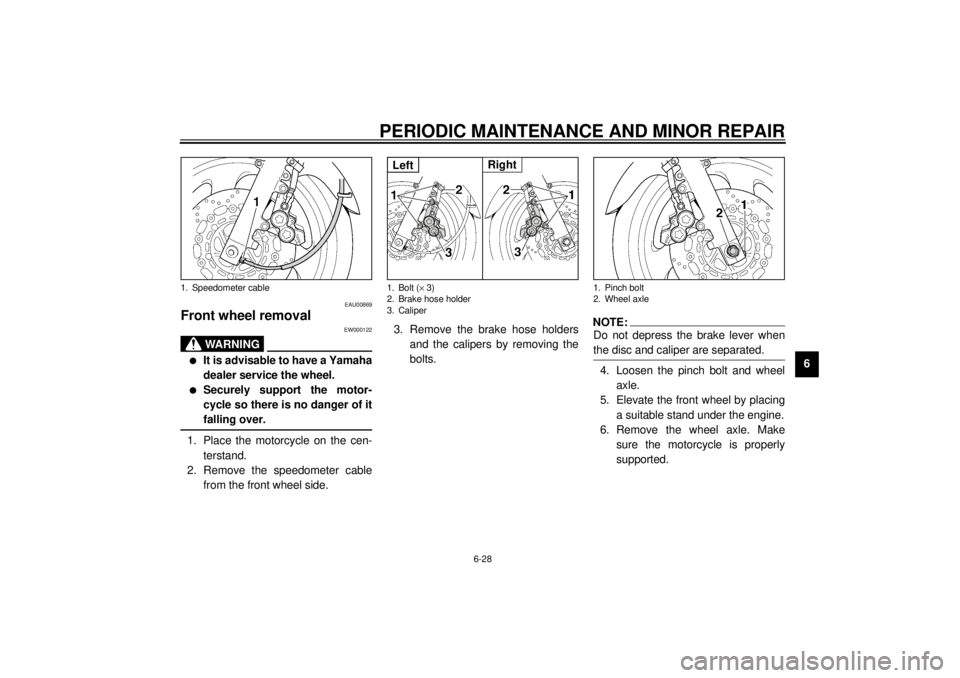
PERIODIC MAINTENANCE AND MINOR REPAIR
6-28
6
EAU00869
Front wheel removal
EW000122
WARNING
@ l
It is advisable to have a Yamaha
dealer service the wheel.
l
Securely support the motor-
cycle so there is no danger of it
falling over.
@1. Place the motorcycle on the cen-
terstand.
2. Remove the speedometer cable
from the front wheel side.3. Remove the brake hose holders
and the calipers by removing the
bolts.
NOTE:@ Do not depress the brake lever when
the disc and caliper are separated. @4. Loosen the pinch bolt and wheel
axle.
5. Elevate the front wheel by placing
a suitable stand under the engine.
6. Remove the wheel axle. Make
sure the motorcycle is properly
supported.
1. Speedometer cable
1. Bolt (´ 3)
2. Brake hose holder
3. CaliperLeft
Right
1. Pinch bolt
2. Wheel axle
Page 73 of 95
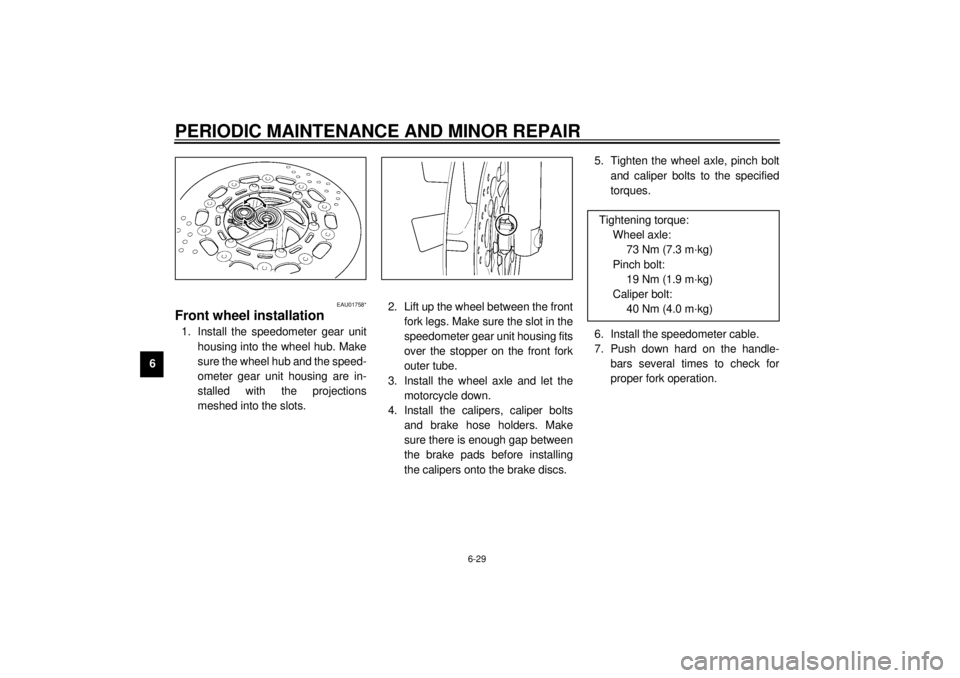
PERIODIC MAINTENANCE AND MINOR REPAIR
6-29
6
EAU01758*
Front wheel installation1. Install the speedometer gear unit
housing into the wheel hub. Make
sure the wheel hub and the speed-
ometer gear unit housing are in-
stalled with the projections
meshed into the slots.2. Lift up the wheel between the front
fork legs. Make sure the slot in the
speedometer gear unit housing fits
over the stopper on the front fork
outer tube.
3. Install the wheel axle and let the
motorcycle down.
4. Install the calipers, caliper bolts
and brake hose holders. Make
sure there is enough gap between
the brake pads before installing
the calipers onto the brake discs.5. Tighten the wheel axle, pinch bolt
and caliper bolts to the specified
torques.
6. Install the speedometer cable.
7. Push down hard on the handle-
bars several times to check for
proper fork operation.
Tightening torque:
Wheel axle:
73 Nm (7.3 m·kg)
Pinch bolt:
19 Nm (1.9 m·kg)
Caliper bolt:
40 Nm (4.0 m·kg)
Page 74 of 95
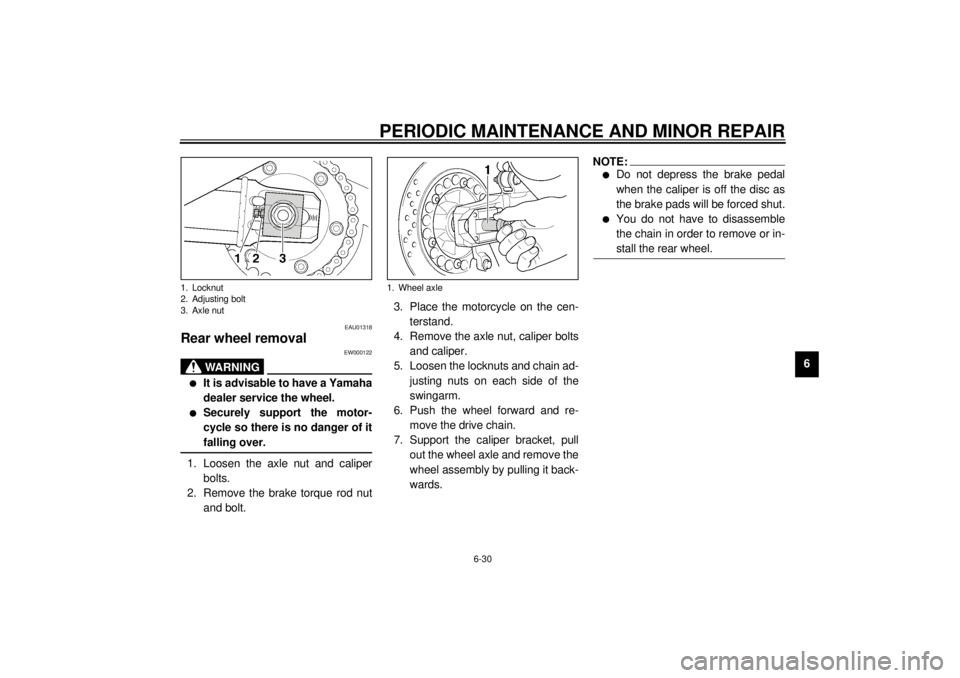
PERIODIC MAINTENANCE AND MINOR REPAIR
6-30
6
EAU01318
Rear wheel removal
EW000122
WARNING
@ l
It is advisable to have a Yamaha
dealer service the wheel.
l
Securely support the motor-
cycle so there is no danger of it
falling over.
@1. Loosen the axle nut and caliper
bolts.
2. Remove the brake torque rod nut
and bolt.3. Place the motorcycle on the cen-
terstand.
4. Remove the axle nut, caliper bolts
and caliper.
5. Loosen the locknuts and chain ad-
justing nuts on each side of the
swingarm.
6. Push the wheel forward and re-
move the drive chain.
7. Support the caliper bracket, pull
out the wheel axle and remove the
wheel assembly by pulling it back-
wards.
NOTE:@ l
Do not depress the brake pedal
when the caliper is off the disc as
the brake pads will be forced shut.
l
You do not have to disassemble
the chain in order to remove or in-
stall the rear wheel.
@
1. Locknut
2. Adjusting bolt
3. Axle nut
1. Wheel axle
Page 75 of 95

PERIODIC MAINTENANCE AND MINOR REPAIR
6-31
6
EAU01317
Rear wheel installation1. Install the caliper bracket and
wheel assembly, then insert the
axle.
2. Install and adjust the drive chain.
(See page 6-19 for details about
adjusting the drive chain slack.)
3. Install the brake torque rod bolt
and nut.
4. Install the caliper and caliper bolts.
Make sure there is enough gap
between the brake pads before in-
stalling the caliper onto the brake
disc.
5. Take the motorcycle off the cen-
terstand.
6. Tighten the axle nut, caliper bolts
and the brake torque rod nut to the
specified torques.
EAU01008
TroubleshootingAlthough Yamaha motorcycles receive
a rigid inspection before shipment from
the factory, trouble may occur during
operation.
Any problem in the fuel, compression,
or ignition systems can cause poor
starting and loss of power. The trouble-
shooting chart describes a quick, easy
procedure for making checks.
If your motorcycle requires any repair,
bring it to a Yamaha dealer. The skilled
technicians at a Yamaha dealership
have the tools, experience, and know-
how to properly service your motor-
cycle. Use only genuine Yamaha parts
on your motorcycle. Imitation parts may
look like Yamaha parts, but they are of-
ten inferior. Consequently, they have a
shorter service life and can lead to ex-
pensive repair bills. Tightening torque:
Axle nut:
150 Nm (15.0 m·kg)
Caliper bolt:
40 Nm (4.0 m·kg)
Brake torque rod nut:
23 Nm (2.3 m·kg)
Page 76 of 95

PERIODIC MAINTENANCE AND MINOR REPAIR
6-32
6
EAU01297
Troubleshooting chart
EW000125
WARNING
@ Never check the fuel system while smoking or in the vicinity of an open flame. @
Check if there is fuel
in the fuel tank.1. Fuel
Enough fuel.
No fuel.
Go to compression check.
Supply fuel.
Use the electric starter.2. Compression
There is compression.
No compression.
Go to ignition check.
Ask a Yamaha dealer to
inspect.
Remove spark
plugs and
check electrodes.3. Ignition
Wet.
Dry.
Wipe clean with dry cloth and correct
spark gap or replace spark plugs.
Ask a Yamaha dealer to inspect.
Engine doesn’t start, go to battery
check.Open throttle half-way and start
the engine.
Use the electric starter.4. Battery
Engine turns over
quickly.
Engine turns over
slowly.
Battery good.Check connections or
recharge.
Engine doesn’t start, ask a Yamaha
dealer to inspect.
Engine doesn’t start, go to compression check.
Page 77 of 95

Page 78 of 95
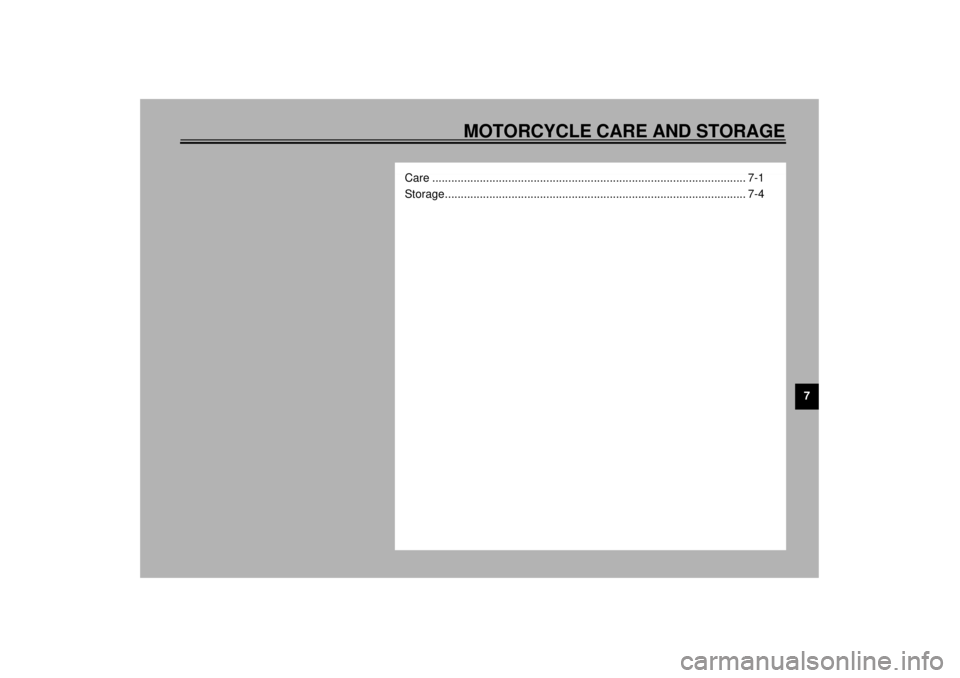
7
MOTORCYCLE CARE AND STORAGE
Care ................................................................................................... 7-1
Storage............................................................................................... 7-4
Page 79 of 95

7-1
7
EAU01517
7-MOTORCYCLE CARE AND STORAGECareThe exposure of its technology makes
a motorcycle charming but also vulner-
able. Although high-quality compo-
nents are used, they are not all rust-re-
sistant. While a rusty exhaust pipe may
remain unnoticed on a car, it does look
unattractive on a motorcycle. Frequent
and proper care, however, will keep
your motorcycle looking good, extend
its life and maintain its performance.
Moreover, the warranty states that the
vehicle must be properly taken care of.
For all these reasons, it is recommend-
ed that you observe the following
cleaning and storing precautions.Before cleaning
1. Cover up the muffler outlets with
plastic bags.
2. Make sure that all caps and covers
as well as all electrical couplers
and connectors, including the
spark plug caps, are tightly in-
stalled.
3. Remove extremely stubborn dirt,
like oil burnt onto the crankcase,
with a degreasing agent and a
brush, but never apply such prod-
ucts onto seals, gaskets, sprock-
ets, the drive chain and wheel
axles. Always rinse the dirt and
degreaser off with water.Cleaning
After normal use
Remove dirt with warm water, a neutral
detergent and a soft clean sponge,
then rinse with plenty of clean water.
Use a tooth or bottle brush for hard-to-
reach parts. Tougher dirt and insects
will come off more easily if the area is
covered with a wet cloth for a few min-
utes before cleaning.
Page 80 of 95
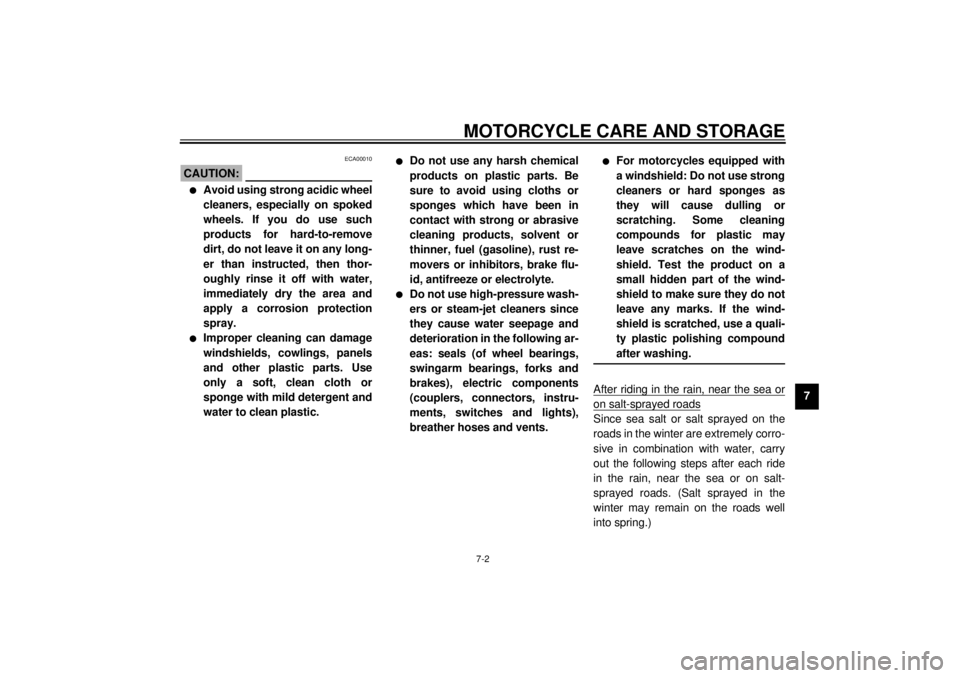
MOTORCYCLE CARE AND STORAGE
7-2
7
ECA00010
CAUTION:@ l
Avoid using strong acidic wheel
cleaners, especially on spoked
wheels. If you do use such
products for hard-to-remove
dirt, do not leave it on any long-
er than instructed, then thor-
oughly rinse it off with water,
immediately dry the area and
apply a corrosion protection
spray.
l
Improper cleaning can damage
windshields, cowlings, panels
and other plastic parts. Use
only a soft, clean cloth or
sponge with mild detergent and
water to clean plastic.
l
Do not use any harsh chemical
products on plastic parts. Be
sure to avoid using cloths or
sponges which have been in
contact with strong or abrasive
cleaning products, solvent or
thinner, fuel (gasoline), rust re-
movers or inhibitors, brake flu-
id, antifreeze or electrolyte.
l
Do not use high-pressure wash-
ers or steam-jet cleaners since
they cause water seepage and
deterioration in the following ar-
eas: seals (of wheel bearings,
swingarm bearings, forks and
brakes), electric components
(couplers, connectors, instru-
ments, switches and lights),
breather hoses and vents.
l
For motorcycles equipped with
a windshield: Do not use strong
cleaners or hard sponges as
they will cause dulling or
scratching. Some cleaning
compounds for plastic may
leave scratches on the wind-
shield. Test the product on a
small hidden part of the wind-
shield to make sure they do not
leave any marks. If the wind-
shield is scratched, use a quali-
ty plastic polishing compound
after washing.
@After riding in the rain, near the sea oron salt-sprayed roadsSince sea salt or salt sprayed on the
roads in the winter are extremely corro-
sive in combination with water, carry
out the following steps after each ride
in the rain, near the sea or on salt-
sprayed roads. (Salt sprayed in the
winter may remain on the roads well
into spring.)